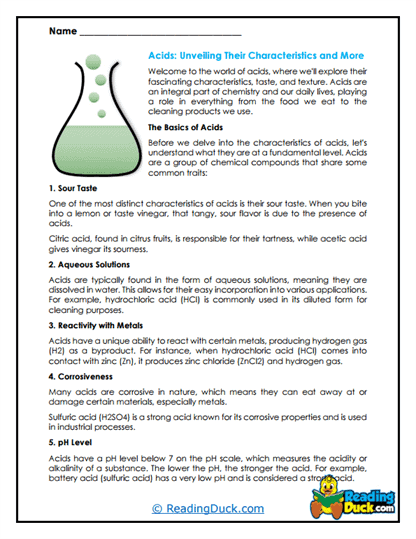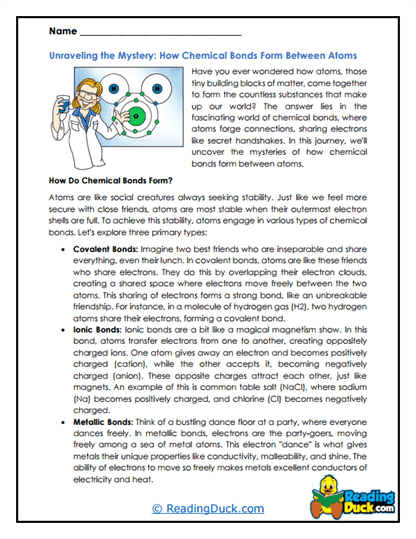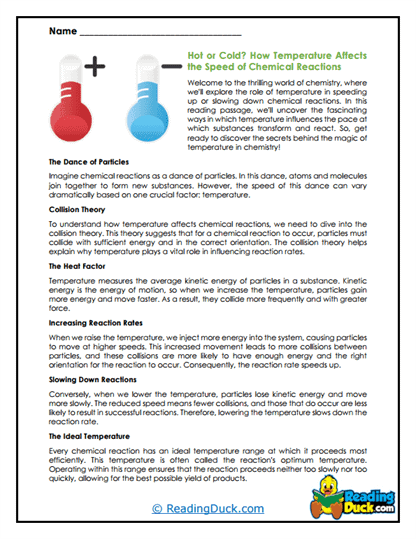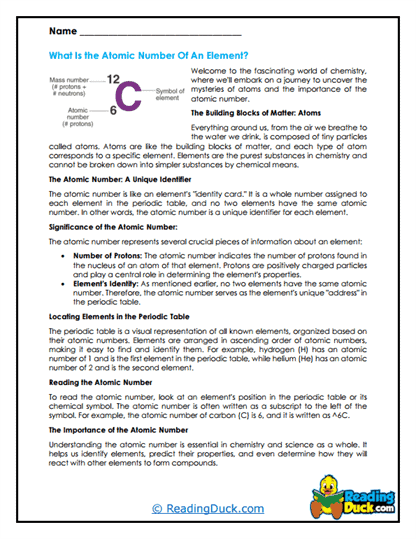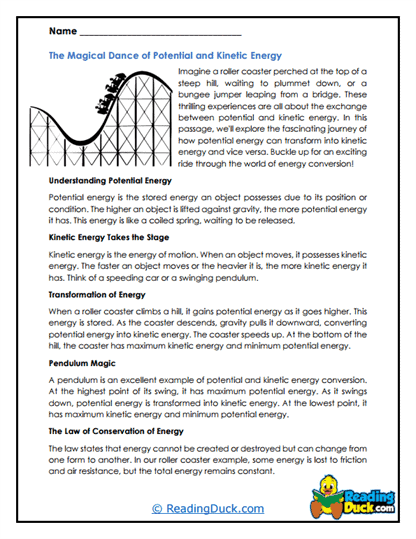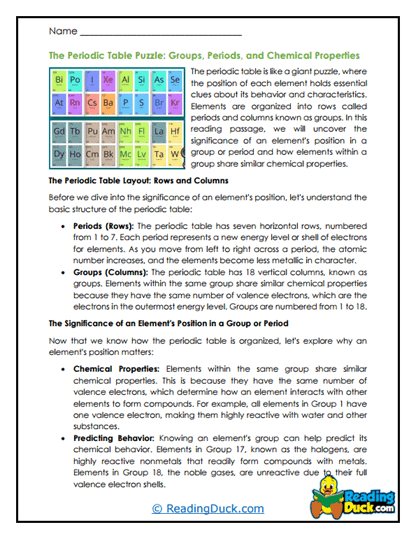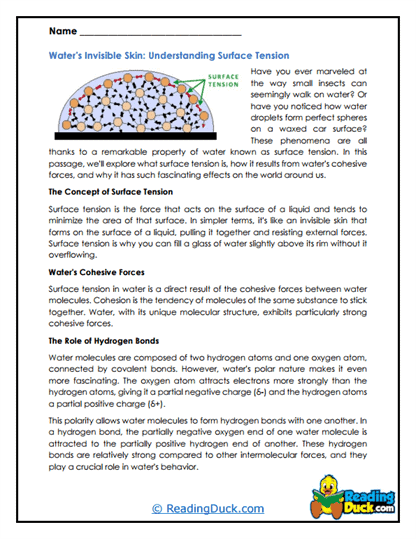Chemistry Worksheets
About Our Chemistry Worksheets
Our Chemistry worksheets offer a comprehensive and engaging exploration of the fundamental concepts that make up the world of chemistry. Designed to spark curiosity and deepen understanding, these worksheets guide students through various aspects of chemistry, from the basics of atomic structure to the complexities of chemical reactions. Whether you're introducing students to the periodic table or explaining the nature of chemical bonds, this collection provides valuable resources to enhance learning and engagement.
This topic contains several sub-topics, each focusing on a specific area of chemistry. These sub-topics are further broken down into multiple worksheet sets, each designed to reinforce students' comprehension and connection to the material through various activities:
- Multiple Choice Questions: These questions assess students' understanding of the reading passages, focusing on key facts and concepts related to the topic. This format helps reinforce students' knowledge and encourages them to engage with the material in a structured manner.
- Short Answer Questions: This format challenges students to reflect on what they’ve learned by writing their responses in their own words. These questions promote deeper thinking and help students articulate their thoughts and insights about the chemical concepts covered.
- Open-Ended Questions: These questions invite students to explore their personal responses to the material, encouraging them to express opinions, preferences, or interpretations related to the topics discussed. This format fosters critical thinking and allows students to connect with the content on a more personal level.
These activities help demonstrate students’ understanding of the material and enhance their connection to the subject matter. Each worksheet set includes an answer key, making it easy for educators to review and evaluate students' progress. All worksheets are available as PDF files, which can be easily viewed electronically, downloaded, and printed.
Exploring the Building Blocks of Matter: An Introduction to Key Concepts in Chemistry
Chemistry is the scientific study of matter and the changes it undergoes. It is often referred to as the "central science" because it connects other sciences, such as physics, biology, and environmental science, providing a foundation for understanding the natural world. When introducing students to chemistry, it’s essential to highlight the basic building blocks of matter and the processes that govern chemical interactions. By studying chemistry, students gain insights into how substances interact, how chemical reactions occur, and how these processes impact everything from the food we eat to the medicines we take.
Key Aspects of Chemistry:
- Acids and Bases: Acids and bases are two fundamental categories of chemicals that play crucial roles in various chemical reactions. Students will explore the properties of acids and bases, how they are measured using the pH scale, and their applications in everyday life, such as in food preservation and cleaning products.
- Atoms and Molecules: The study of atoms and molecules is the foundation of chemistry. Students will learn about atomic structure, including protons, neutrons, and electrons, and how these particles combine to form molecules. Understanding atoms and molecules is essential for grasping more complex chemical concepts.
- Chemical Bonds: Chemical bonds are the forces that hold atoms together in molecules. Students will explore different types of bonds, such as covalent, ionic, and metallic bonds, and how these bonds determine the properties of substances. This topic is critical for understanding how compounds are formed and how they interact in chemical reactions.
- Chemical Reactions: Chemical reactions involve the transformation of substances through the breaking and forming of chemical bonds. Students will learn about different types of chemical reactions, such as synthesis, decomposition, and combustion, and the factors that influence reaction rates. Understanding chemical reactions is key to understanding the processes that occur in nature and in industrial applications.
- Elements: Elements are pure substances made up of only one type of atom, and they are the building blocks of all matter. Students will explore the periodic table of elements, learning about the properties of different elements, their classifications, and how they combine to form compounds. The periodic table serves as a roadmap for understanding chemical behavior.
- Kinetic and Potential Energy: Energy plays a vital role in chemical processes. Students will explore the concepts of kinetic and potential energy, how they relate to the movement and position of particles, and how energy changes during chemical reactions. This topic is essential for understanding the principles of thermodynamics and energy conservation in chemistry.
- Periodic Table of Elements: The periodic table is a systematic arrangement of elements based on their atomic number, electron configuration, and recurring chemical properties. Students will learn how to use the periodic table to predict the behavior of elements, understand trends in chemical reactivity, and explore the history of its development by Dmitri Mendeleev.
- Phases of Matter: Matter exists in different phases, such as solids, liquids, gases, and plasma. Students will learn about the characteristics of each phase, the changes that occur during phase transitions, and the factors that influence these changes, such as temperature and pressure. Understanding phases of matter is crucial for studying material properties and physical chemistry.
- Water Properties: Water is a unique and essential substance with properties that make it vital for life. Students will explore the structure of water molecules, hydrogen bonding, and the properties of water that make it an excellent solvent, such as cohesion, adhesion, and its high specific heat capacity. Water's properties are central to many chemical and biological processes.
These topics provide students with a comprehensive understanding of chemistry and its significance. By exploring these aspects, students can develop a curiosity and appreciation for the chemical principles that govern the natural world and the scientific methods used to study them.
Examples of Real-World Applications
Chemistry is not just a theoretical science; it has numerous real-world applications that affect our daily lives and our understanding of the natural world. Here are some key examples:
- Medicine and Pharmaceuticals: Chemistry is at the heart of drug development and the creation of new medical treatments. Understanding chemical interactions helps scientists design drugs that target specific biological processes, leading to more effective treatments for diseases.
- Agriculture and Food Production: Chemistry plays a crucial role in agriculture, from the development of fertilizers and pesticides to the preservation of food. Chemical principles are used to enhance crop yields, protect plants from pests, and ensure the safety and shelf life of food products.
- Environmental Protection: Chemistry is essential for understanding environmental issues, such as pollution, climate change, and waste management. Chemical analysis helps identify pollutants, develop sustainable materials, and create technologies for reducing environmental impact.
- Energy Production: Chemistry is central to the production and storage of energy. From fossil fuels to renewable energy sources like solar and wind, understanding chemical reactions allows for the development of efficient energy technologies, such as batteries, fuel cells, and biofuels.
- Materials Science: Chemistry is fundamental to the development of new materials with specific properties, such as plastics, ceramics, and composites. These materials are used in various industries, from construction and electronics to aerospace and medical devices.
- Forensic Science: Chemistry plays a vital role in forensic science, where chemical analysis is used to investigate crimes. Techniques such as chromatography, spectroscopy, and DNA analysis help forensic scientists identify substances, trace evidence, and solve criminal cases.
How to Integrate These Worksheets in a Learning Curriculum
To effectively incorporate our Chemistry worksheets into your curriculum, here are some tips for teachers and parents:
- Thematic Lessons: Organize lessons around specific chemical themes or topics. For example, dedicate a week to studying chemical reactions, culminating in a lab experiment where students observe and record the results of a simple chemical reaction.
- Cross-Disciplinary Connections: Link chemistry with other subjects such as physics, biology, and environmental science. For instance, explore the chemical processes involved in photosynthesis, or discuss the role of chemistry in renewable energy technologies.
- Interactive Learning: Use multimedia resources like documentaries, interactive simulations, or virtual labs to complement the worksheets. This will help students visualize complex chemical concepts and engage with the material in an interactive way.
- Creative Projects: Encourage students to create their own models of molecules, design a poster explaining the periodic table trends, or write a report on the environmental impact of a specific chemical. These projects allow students to apply their knowledge creatively.
- Group Discussions and Presentations: Use the open-ended questions in the worksheets to prompt group discussions or presentations. This will help students develop critical thinking skills and encourage them to express their ideas and interpretations.
- Laboratory Experiments: If possible, complement the worksheets with hands-on laboratory experiments that allow students to observe chemical reactions, measure properties of substances, and practice safe laboratory techniques. This hands-on approach reinforces the concepts learned in the worksheets.
By integrating these strategies into your curriculum, you can help students develop a deeper understanding of chemistry, foster their curiosity about the material world, and enhance their scientific literacy. The Chemistry worksheets are a valuable resource that can be used in a variety of educational settings, making the study of chemical principles accessible and engaging for all students. Through consistent practice and exploration, students will not only learn about the building blocks of matter but also develop a lifelong appreciation for the science of chemistry.
